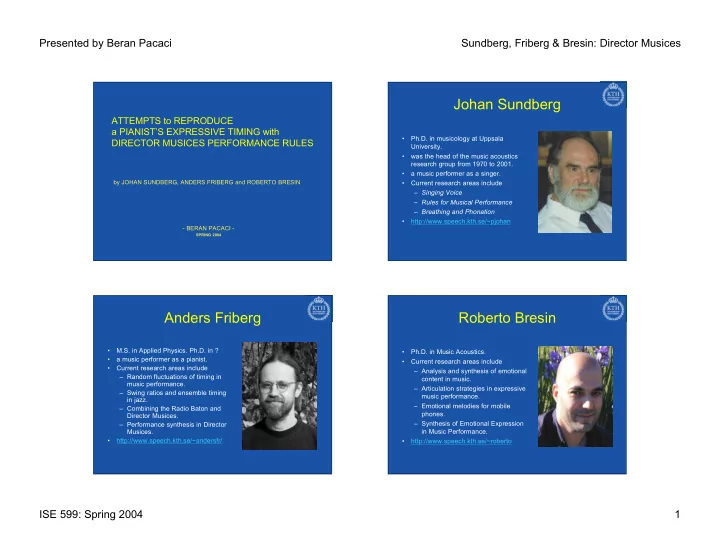

Presented by Beran Pacaci Sundberg, Friberg & Bresin: Director Musices Johan Sundberg ATTEMPTS to REPRODUCE a PIANIST’S EXPRESSIVE TIMING with • Ph.D. in musicology at Uppsala DIRECTOR MUSICES PERFORMANCE RULES University. • was the head of the music acoustics research group from 1970 to 2001. • a music performer as a singer. by JOHAN SUNDBERG, ANDERS FRIBERG and ROBERTO BRESIN • Current research areas include – Singing Voice – Rules for Musical Performance – Breathing and Phonation • http://www.speech.kth.se/~pjohan - BERAN PACACI - SPRING 2004 Anders Friberg Roberto Bresin • M.S. in Applied Physics. Ph.D. in ? • Ph.D. in Music Acoustics. • a music performer as a pianist. • Current research areas include • Current research areas include – Analysis and synthesis of emotional – Random fluctuations of timing in content in music. music performance. – Articulation strategies in expressive – Swing ratios and ensemble timing music performance. in jazz. – Emotional melodies for mobile – Combining the Radio Baton and phones. Director Musices. – Synthesis of Emotional Expression – Performance synthesis in Director Musices. in Music Performance. • http://www.speech.kth.se/~andersfr/ • http://www.speech.kth.se/~roberto ISE 599: Spring 2004 1
Presented by Beran Pacaci Sundberg, Friberg & Bresin: Director Musices Music Performance KTH Music Acoustics Group • runs in four main streams: • is an important research area today. – singing (solo and choral) • The deviation from nominal inter-onset- – stringed instruments interval (IOI). – music performance • Every musician plays differently. – computer music composition Music Performance Rules Music Performance Rules • Differentiation Rules The rules are divided into three main classes: – Duration Contrast ÿ Differentiation Rules: enhance the differences – Melodic Charge between tone categories. – High Sharp ÿ Grouping Rules: show what tones belong together. • Grouping Rules ÿ Emphasis Rules: emphasize unexpected notes. – Punctuation – Double Duration – Tuning ÿ Ensemble Rules: synchronize the various voices in – Phrase Arch an ensemble. – Inégales (or swing) – Ensemble Swing – Final Ritard – Harmonic Charge ISE 599: Spring 2004 2
Presented by Beran Pacaci Sundberg, Friberg & Bresin: Director Musices Director Musices (DM) Director Musices (DM) • a software for Automatic Music Performance. • DM rules contain two elements: • a rule system for Musical Performance. ÿ Context • implementing all previously defined rules. ÿ Quantity • features includes polyphony, midi I/O, performance variable graphs and user rule definition. Director Musices (DM) Research Strategy • Analysis-by-synthesis • Analysis-by-measurement ISE 599: Spring 2004 3
Presented by Beran Pacaci Sundberg, Friberg & Bresin: Director Musices Experiment Outline Experiment Outline • Initial Run: Each rule is tested one by one. • Comparison between the real pianist’s Duration Contrast, Melodic Charge, performance with different performances Punctuation, Double Duration, Phrase produced by the DM system. Arch, Harmonic Charge, Faster-uphill and • MIDI data consists of score time in beats, Leap-tone-duration. MIDI note numbers, IOI, sounded duration • Second Run: Combinations of rules are and dynamics in MIDI velocity. tested. First Phrase Arch Rule, then combining with Harmonic Charge and Duration Contrast. Limitation of Correlation Conclusion • The sign of the overall deviations is • The Phrase Arch rule is the winner in the considered, not their quantity. experimented performance. • The correlation is highly sensitive to • Rule combination has to change between extreme values. sections. • The correlation is much more sensitive to • Time varying rule palettes would be a the agreement for single notes when the worthwhile target. number of notes compared is small as • DM limitation: The general applicability of compared to when it is large. the rule combination. ISE 599: Spring 2004 4
Presented by Beran Pacaci Sundberg, Friberg & Bresin: Director Musices References • Ramon Lopez de Mantaras & Josep Lluis Arcos (2002). AI and Music From Composition to Expressive Performance. • Efstathios Stamatatos & Gerhard Widmer (2002). Music Performer Recognition Using an Ensemble of Simple Classifiers. • The Science of Music Performance http://www.speech.kth.se/music/performance/ ISE 599: Spring 2004 5
Recommend
More recommend